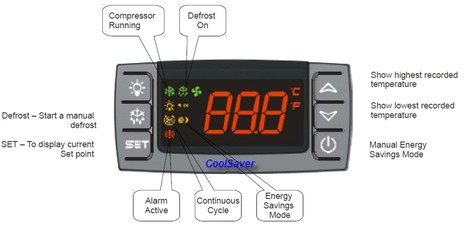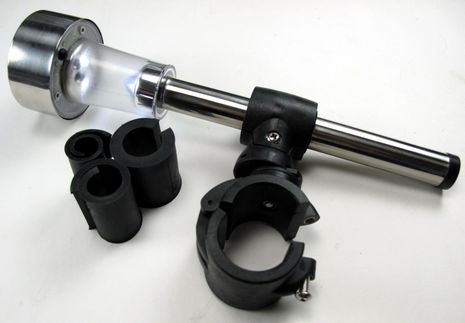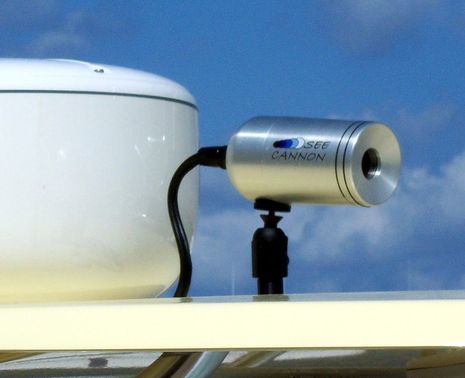Category: Cabin & deck gear

The final product photography isn’t finished yet, but there’s certainly enough info up at CoolSaver.net to discuss this interesting advance in refrigeration control for power-conscious cruisers. What seems unique is a feature called Charge Sense, which can push fridge temps down to a user set low when there’s excess power available from an alternator, generator, or solar array, and conversely minimize power use when it’s scarce. Which, if it works well, could be a pretty big deal on a lot of boats, including my own Gizmo…

It’s just a draft — artist I’m not — but maybe someone out there in Panbo land can craft this into something fun for a hat and business card? The graphic idea is an electronic wave turning into an ocean wave, but I’m open to another design…as long as it floats some boats. Seriously, the first hat (a nice long billed khaki cap) will be yours, plus my undying gratitude. (If it would help to start with my draft creation in vector form, you can download it as an .ai file.) Homework is completely optional, of course, and you, like me, may have a holiday to celebrate…

One good sign: Recently, a friend who’d eaten at a waterfront restaurant called to ask if I knew “that there was a bright white light shining on Gizmo’s flying bridge?” Now, in truth, Gizmo’s float is just a few hundred feet from the deck of that restaurant and the SolLight RailLight Mini isn’t all that bright, but it sure is easy to install and use…

The name “See Cannon” doesn’t exactly roll off the tongue, but the concept is interesting. Encase a new generation ultra low lux camera in a small aluminum housing sealed to IP66 standards, offer a variety of 12v/video cable and marine mounting options, and market it as night vision for the many boaters who yearn for true thermal vision but can’t quite afford it. That seems to be the strategy of newcomer Night to Day Camera Systems, and I suspect its success turns largely on just what “ultra low” means…
Yes, the photo is largely under exposed, but the point was to illustrate the relative brightness of the new Green Marine LED-backlit AWM-1900 monitor I checked out in the lab last week. I think it would be usable in sunny conditions, and it’s fast enough to show an action movie without noticeable blur, either in a PIP window as shown, or full screen. It was also pleasantly surprising to find that even an inexpensive Asus netbook (dimly showing neat NavMonPC freeware) supports a dual monitor desktop these days, including the AWM’s 1280 x 1024 native resolution. I did not test the monitor’s promised front side waterproofness, but it’s quite apparent that the back side has to be well protected…
That’s a beautifully built Interphase forward looking sonar (FLS) transducer — actually two phased array transducers, one 90� vertical and one 90� horizontal, cast into the same epoxy block (hence the dual outputs). It can be used with several Interphase FLS models, but I’m looking forward to trying it with the company’s new Ultrascan PC90, discussed here last Fall. And I went to some trouble, including the careful band sawing of that fairing block above, to give it a good view. In fact, some may call me crazy…
I drove the dogs in my neighborhood slightly nuts, but I did satisfy myself that this new loudhailer horn speaker works quite well. Mister Fish Marine Electronics is primarily an online dealer, but this 40 watt, 4 ohm speaker is their own design. The goal was improved longevity and sound over the “inexpensive” speakers while maintaining a reasonable cost, and my first impression — given the $89 price, shipping included — is “goal achieved.” It feels solidly built and purportedly contains “lubricated internal o-ring gaskets” and all stainless hardware. And sounds darn good, which I was able to test in multiple ways thanks to the Garmin VHF 200…
In Miami I got a good introduction to OceanLED’s new line of LIET LED down lighting fixtures, and was thoroughly intrigued. LIET (old English for “light” and pronounced the same way) seems to represent a significant technological leap. That LIET6 core above, for instance, is less than five inches in diameter and a half inch thick, but produces what’s claimed to be the equivalent of a 50w Halogen bulb while only using 5.3 watts of power. It even has built-in diagnostics and dimming. And while blindingly bright, it doesn’t get hot to finger touch even though it lacks a discernible heat sink. How did they do it?
Last summer I tried both SeaView and ScanStrut radar mounts, and was impressed with both. I also got the sense that these are two able companies in healthy competition. No surprise then that SeaView has just introduced electronics pods not unlike the ScanPod (originally called the DeckPod) that I also tested last season. That big ScanStrut housing held up pretty well to the weight of a Raymarine C140 though it did jiggle a bit in rough going and I did have to adjust the clamp once. SeaView’s design, above, looks to have two clamps and maybe more bearing surface, and I’ll be curious to get a feel for its range of motion and rigidity when clamped. Maybe in Miami? Meanwhile, ScanStrut has moved into cable deck seals…
Weird world that it is, I first learned of EasyBailer via Twitter, even though the “factory” is just down the coast. Last week I stopped in and met “CEO” John Bianchi in his shop full of small boats, including an impressive plank-on-frame Rangeley Guideboat he build himself. Thus I wasn’t surprised to see how neatly put together his solar-powered dinghy pump is (click above for detail). And I consider myself somewhat expert about this as I tried to assemble a similar bailer myself with poor results…













